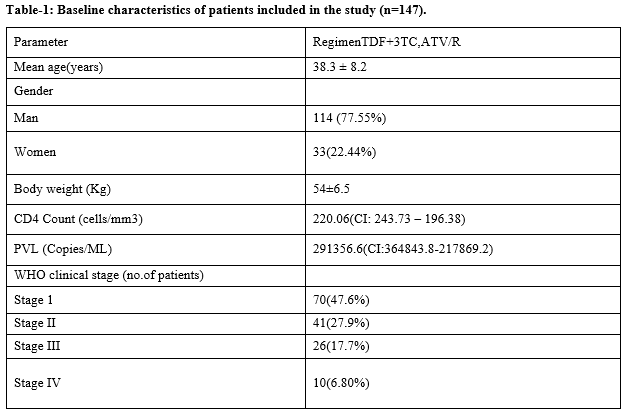Virological outcomes of second-line antiretroviral therapy for HIV-1 patients in center of excellence, Gandhi Hospital, Secundrabad, Telangana
Abstract
Introduction: In India, ART service was established in 2004 and viral load facility was started in 2009 through National Public Health Laboratory (NPHL). Phased scale-up has been planned to efficiently and successfully expand viral load testing services, taking into account the targets for enrollment of People Living with HIV in to Anti Retroviral Therapy program.
Methods: This is an observational study conducted at the Centre of Excellence (COE), Gandhi Hospital Secundrabad. It is a referral centre for evaluation of patients suspected of treatment failure from ART centers. Data of all patients >18 years of age who were started on second line therapy due to failure of first line ART was taken in the study. The data of patients admitted between the time period of January 2009 to January 2010 was included.
Results: A total of 147 HIV infected patients received second line ART of which 114 were men and 33 were women. Of these, 147 were treated with regimen TL, ATV/r. The most common cause to switch on second line ART was combined immunological and clinical failure (135) followed by all three failure (12).Mean baseline CD4 count was 220.06 (95% confidence interval [CI]: 243.73-196.38) and mean base line of PVL of patients was 291356.6 cells/mm3 (95% CI: 364843.8-217869.29) copies/ml, respectively.
Conclusion: Good long term outcome as well as virological suppression in patients starting second line therapy under programmatic conditions in India. This early mortality can be circumvented by introducing routine virological monitoring in the program which will help in early detection of patients with failure.
Downloads
References
Department of AIDS Control, Ministry of Health & Family Welfare, Government of India. NACO AIDS Control Programme Phase-IV (2012-2017): Strategy Document. [accessed on December 8, 2016]. Available from: http://naco.gov.in/sites/default/files/Strategy_Document_NACP%20IV.pdf .
Hammer SM, Saag MS, Schechter M, Montaner JS, Schooley RT, Jacobsen DM, et al. Treatment for adult HIV infection: 2006 recommendations of the International AIDS Society-USA panel. JAMA. 2006; 296 (7):827-43. DOI: https://doi.org/10.1001/jama.296.7.827
UNAIDS 90-90-90: treatment for all. http://www.unaids.org/en/resources/909090. Accessed 23 June 2018.
Palella FJ Jr, Deloria-Knoll M, Chmiel JS, Moorman AC, Wood KC, Greenberg AE, et al. Survival benefit of initiating antiretroviral therapy in HIV-infected persons in different CD4+ cell strata. Ann Intern Med. 2003; 138(8): 620-6. DOI: https://doi.org/10.7326/0003-4819-138-8-200304150-00007
Ojha CR, Shakya G, Dumre SP. Virological and Immunological Status of the People Living with HIV/AIDS Undergoing ART Treatment in Nepal. Biomed Res Int. 2016;2016:6817325. DOI: https://doi.org/10.1155/2016/6817325. Epub 2016 Jul 28.
National technical guidelines in HIV/AIDS, India Available at http://naco.gov.in/sites/default/files/NACO%20-%20National%20Technical%20Guidelines%20on%20ART_October%202018%20%281%29.pdf
Chakravarty J, Sundar S, Chourasia A, Singh PN, Kurle S, Tripathy SP, et al. Outcome of patients on second line antiretroviral therapy under programmatic condition in India. BMC Infect Dis. 2015;15:517. DOI: https://doi.org/10.1186/s12879-015-1270-8.
Khan S, Das M, Andries A, Deshpande A, Mansoor H, Saranchuk P, et al. Second-line failure and first experience with third-line antiretroviral therapy in Mumbai, India. Glob Health Action. 2014;7:24861. DOI: https://doi.org/10.3402/gha.v7.24861. eCollection 2014.
Sungkanuparph S, Manosuth W, Kiertiburanakul S, Piyavong B, Chumpathat N, Chantratita W. Options for a second-line antiretroviral regimen for HIV type 1-infected patients whose initial regimen of a fixed-dose combination of stavudine, lamivudine, and nevirapine fails. Clin Infect Dis. 2007;44(3):447-52. DOI: https://doi.org/10.1086/510745
Pujades-Rodríguez M, O'Brien D, Humblet P, Calmy A. Second-line antiretroviral therapy in resource-limited settings: the experience of Médecins Sans Frontières. AIDS. 2008;22(11):1305-12. DOI: https://doi.org/10.1097/QAD.0b013e3282fa75b9.
Fox MP, Ive P, Long L, Maskew M, Sanne I. High rates of survival, immune reconstitution, and virologic suppression on second-line antiretroviral therapy in South Africa. J Acquir Immune DeficSyndr. 2010; 53(4): 500-6. DOI: https://doi.org/10.1097/QAI.0b013e3181bcdac1.
NACO annual report 2010-11. [Last accessed on 2012 Aug 10]. Available from: http://www.nacoonline.org/Quick_Links/Directory_of_HIV_Data .
Ferradini L, Ouk V, Segeral O, Nouhin J, Dulioust A, Hak C, et al. High efficacy of lopinavir/r-based second-line antiretroviral treatment after 24 months of follow up at ESTHER/Calmette Hospital in Phnom Penh, Cambodia. J Int AIDS Soc. 2011;14:14. DOI: https://doi.org/10.1186/1758-2652-14-14.
Patel D, Desai M, Shah AN, Dikshit RK., Early outcome of second line antiretroviral therapy in treatmentexperiencedhuman immunodeficiency virus positive patients Perspect Clin Res. 2013;4(4): 215–220. DOI: https://dx.doi.org/10.4103%2F2229-3485.120170



 OAI - Open Archives Initiative
OAI - Open Archives Initiative


